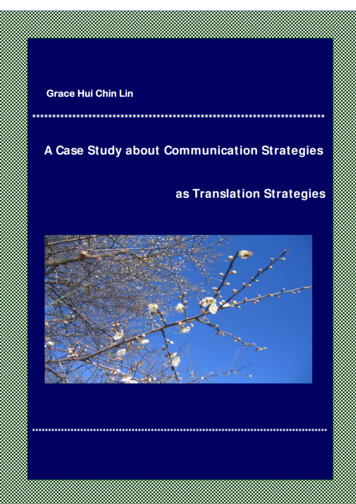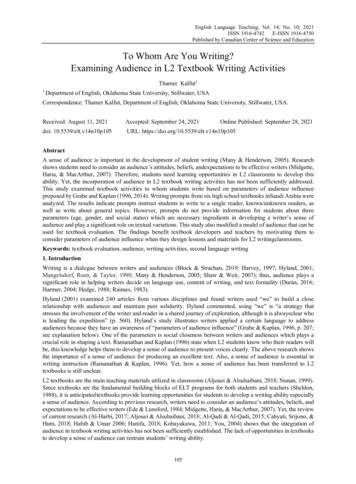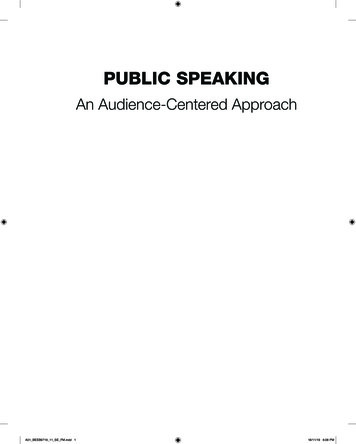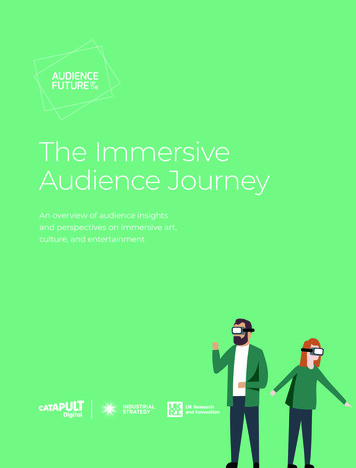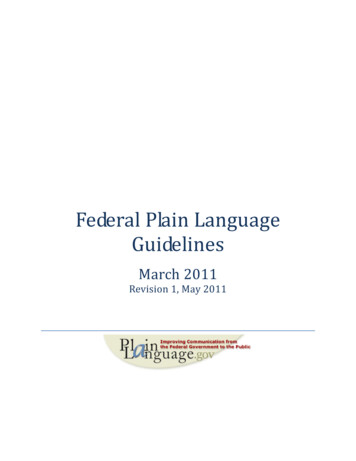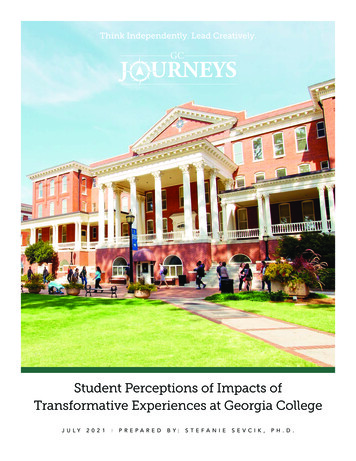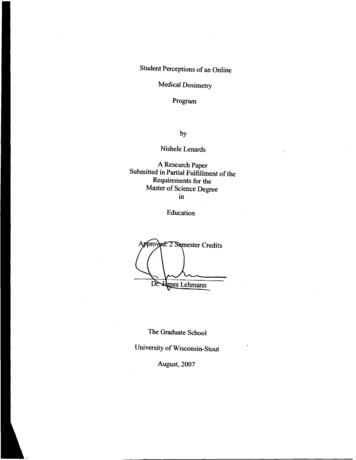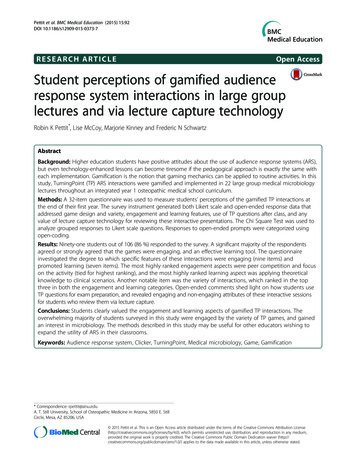
Transcription
Pettit et al. BMC Medical Education (2015) 15:92DOI 10.1186/s12909-015-0373-7RESEARCH ARTICLEOpen AccessStudent perceptions of gamified audienceresponse system interactions in large grouplectures and via lecture capture technologyRobin K Pettit*, Lise McCoy, Marjorie Kinney and Frederic N SchwartzAbstractBackground: Higher education students have positive attitudes about the use of audience response systems (ARS),but even technology-enhanced lessons can become tiresome if the pedagogical approach is exactly the same witheach implementation. Gamification is the notion that gaming mechanics can be applied to routine activities. In thisstudy, TurningPoint (TP) ARS interactions were gamified and implemented in 22 large group medical microbiologylectures throughout an integrated year 1 osteopathic medical school curriculum.Methods: A 32-item questionnaire was used to measure students’ perceptions of the gamified TP interactions atthe end of their first year. The survey instrument generated both Likert scale and open-ended response data thataddressed game design and variety, engagement and learning features, use of TP questions after class, and anyvalue of lecture capture technology for reviewing these interactive presentations. The Chi Square Test was used toanalyze grouped responses to Likert scale questions. Responses to open-ended prompts were categorized usingopen-coding.Results: Ninety-one students out of 106 (86 %) responded to the survey. A significant majority of the respondentsagreed or strongly agreed that the games were engaging, and an effective learning tool. The questionnaireinvestigated the degree to which specific features of these interactions were engaging (nine items) andpromoted learning (seven items). The most highly ranked engagement aspects were peer competition and focuson the activity (tied for highest ranking), and the most highly ranked learning aspect was applying theoreticalknowledge to clinical scenarios. Another notable item was the variety of interactions, which ranked in the topthree in both the engagement and learning categories. Open-ended comments shed light on how students useTP questions for exam preparation, and revealed engaging and non-engaging attributes of these interactive sessionsfor students who review them via lecture capture.Conclusions: Students clearly valued the engagement and learning aspects of gamified TP interactions. Theoverwhelming majority of students surveyed in this study were engaged by the variety of TP games, and gainedan interest in microbiology. The methods described in this study may be useful for other educators wishing toexpand the utility of ARS in their classrooms.Keywords: Audience response system, Clicker, TurningPoint, Medical microbiology, Game, Gamification* Correspondence: rpettit@atsu.eduA. T. Still University, School of Osteopathic Medicine in Arizona, 5850 E. StillCircle, Mesa, AZ 85206, USA 2015 Pettit et al. This is an Open Access article distributed under the terms of the Creative Commons Attribution ), which permits unrestricted use, distribution, and reproduction in any medium,provided the original work is properly credited. The Creative Commons Public Domain Dedication waiver ) applies to the data made available in this article, unless otherwise stated.
Pettit et al. BMC Medical Education (2015) 15:92BackgroundAccording to Prince [1], the core elements of activelearning are the introduction of activities into the traditional lecture, and the promotion of student engagement. Audience response systems (ARS), or clickers, areactive learning tools that involve most to all students ina classroom. ARS were designed to electronically polllarge groups, allowing individual responses on hand-heldkeypads, and immediate reporting of aggregated results(feedback) in graphic form. Although ARS have beenavailable for decades, widespread use in higher educationwasn’t until 2003 [2]. As summarized in several usefulreview articles [2–6], higher education students havepositive attitudes about the use of ARS, and perceivethat they are more attentive and engaged when ARS isused during lectures.It is widely recognized that active learning yields positive learning outcomes [1, 7–9]. Students who engageinteractively with each other and with the instructorlearn concepts better, retain them longer, and can applythem more effectively in other contexts than studentswho sit passively listening [7, 8, 10]. Most health professions education students perceive learning benefits withARS, and meta-analysis suggests that ARS’ impact onlearning outcomes is neutral to moderately beneficial[6]. The magnitude of the ARS effect depends on a number of factors, particularly the intervention against whichARS is compared. Not surprisingly, studies comparingARS to other interactive teaching modalities showed lessimpact on knowledge outcomes than those comparingARS to non-interactive teaching [6]. Future researchusing randomized methods should help elucidate thelearning outcome benefits of ARS.ARS are considered useful instructional tools becausethey increase interaction between faculty and students,allow for formative assessment of student knowledge,maintain students’ attention during lectures, and focusstudents’ attention on key points [11]. Multiple studieshave shown that students feel engaged during ARS interactions [12–16]. However, as indicated by Pattersonet al. [17] and Kay and LeSage [2], the specific featuresof these interactions that are engaging for students arenot well described.The core elements of active learning, student activityand engagement, are central to educational game theory[18–21]. Games are growing in popularity at all levels ofeducation, including medical education [22–35], and include simulations, virtual environments, social and cooperative play, and alternative reality games [18]. A surveyof family medicine and internal medicine residency programs directors in the United States indicated that 80 %used games as an educational strategy in their residencytraining programs [23]. While there is evidence that students find games more enjoyable and stimulating thanPage 2 of 15standard lectures [33, 35], evidence for their utility in increasing knowledge is conflicting, perhaps in part due tothe limited number of rigorous studies [18].Gamification is the integration of gaming elements,mechanics and frameworks into non-game situationsand scenarios [36]. The purpose of gamification is tomake routine activities fun, interesting and addictive [20,37]. When designing learning games, educators can drawfrom the corporate world’s ‘playbook’ of game dynamicsby incorporating game pleasure elements such as challenge, surprise, and pride in accomplishment, and gamemechanics such as rules, competition and immediatefeedback [20, 37].We introduced multiple game elements and mechanics[20, 37] into year 1 medical microbiology TurningPoint(TP) ARS presentations (detailed under Methods), andexplored explanations for student engagement. Literatureregarding gamification of TP is scarce. Very recently,Schlegel and Selfridge [38] reported the use of audienceresponse technology to implement a team review game onthe last day of a Dermatology course. The authors statethat the game promoted learning and student satisfaction,but no data are provided. To our knowledge, the engagement aspects of gamified TP interactions have notbeen studied.As Cain and Robinson [4] discussed, clickers do notmagically transform a classroom; how they’re used determines their effectiveness. Therefore, the aim of this studywas to provide insight into best practices for ARS engagement in a year 1 osteopathic medical student (OMS1)large group classroom setting. This study comprises partof an A.T. Still University School of Osteopathic Medicinein Arizona (ATSU SOMA) goal to improve technologyenhanced active learning in our curriculum [39]. With thegoal of increasing engagement in large group medicalmicrobiology sessions, we developed and implemented avariety of TP interactions, including game interactions,during academic year 2013/2014 (Class of 2017, year 1).Our hypothesis was that students would be engaged bythe variety of TP interactions. The following researchquestions were posed: In which ways do TP games fosterengagement? Do students perceive any learning benefitfrom the TP games? Are there gender differences betweenstudent perceptions of the TP games? How do studentsuse the questions from TP games after class? Do studentswho review the TP games via lecture capture (video/audiorecording of large group lectures that students can viewon their personal devices) perceive learning gains or assignany engagement value?The results of this investigation begin to address areasof TP ARS research that have not been well-studied:gamification, specific engagement features of gamifiedTP ARS interactions, use of TP questions after class, anduse by students that review using lecture capture.
Pettit et al. BMC Medical Education (2015) 15:92MethodsAudience response systemsWireless keypads (clickers) and a receiver were purchasedfrom TurningPoint Technologies (Youngstown, OH).Clickers (ResponseCard NXT) for each student in theclass of 2017 were purchased by ATSU SOMA. All TPinteractions for the present study were implemented in theanonymous mode. Student clicker numbers, not studentnames, were displayed on competition slides. There wereno points/grades associated with the TP ARS activities.Construction of the TP gamesTurningPoint operates as a PowerPoint plug-in. A menufor customizing TP interactions appears when TurningPoint is selected from the menu in PowerPoint. Pull-downtabs can be used to create different types of questions(true/false, multiple choice, short answer, numeric response), insert objects (custom correct answer indicator,various types of summary charts, countdown timer), buildin competition (team assignment, team leader board, teamMost Valuable Player [MVP], participant leader board,fastest responder, wager), and create peer teaching slides(comparative links). Images, video and audio can beimported into TP slides. The questions in this studyPage 3 of 15ranged from basic knowledge to clinical vignettes requiring application and analysis. The majority of the questionswere clinical vignettes with multiple choice answers, mimicking the style of the United States Medical LicensingExamination (USMLE) and the Comprehensive Osteopathic Medical Licensing Examination of the UnitedStates (COMLEX-USA). For individual and team competitions, individual participant boards or team leader boardswere spaced at intervals throughout a presentation totrack individual clicker ID numbers and scores, or teamnames and scores.Games can be defined as outcome-oriented activitiesthat proceed according to a set of rules and often involvedecision making [40]. Outcome or goal-oriented activitiesare salient to adult learners [41], and specifically, tomedical students (McCoy et al., submitted). TP ARS interactions inherently have a few game elements andmechanics, for example, the action of clicking the device and the real-time information flow (immediatefeedback). We introduced many more game elementsand mechanics [20, 37] into our TP ARS large group interactions: rules, objects (e.g. leader boards inserted atintervals to show points accumulated during the gameby each player or team (Fig. 1a), custom correct answerFig. 1 TP slides showing examples of gamification elements and the variety of TP ARS interactions. (a) participant leaderboard (b) mystery bugquestion (image used with permission from S.E. Gould, uld/); correct answer indicator (microbe image from CDC Newsroom Image Library) (c) fastest correct responder (d) teamcompetition (e) peer teaching (f) winner of individual participant competition (cheerleader image from FreeDigitalPhotos.net) (g) wagering (diceimage by Stephen Silver at Open Clip Art Library via Wikimedia Commons) (h) identifying misconceptions prior to introducing new material;correct answer indicator (microbe image by Janice Haney Carr at Public Health Image Library) (i) ranking responses
Pettit et al. BMC Medical Education (2015) 15:92indicators representing the organism being discussed(Fig. 1b), mystery bug character for rapid review(Fig. 1b)); action using fastest responder slides insertedafter simple recall-type questions (Fig. 1c); collaborationusing team competitions where students join teams at thegame outset by clicking on their team letter (Fig. 1d); peerteaching where students answer a question individuallyusing their clickers, then discuss the question with aneighbor, and answer the question again using any knowledge gained (Fig. 1e); individual and team competition(individual or team leader boards (Fig. 1f shows an individual leader board at the end of a gamified TP ARS interaction)); social fabric (the idea that people like oneanother better after they’ve played games together, build ahigher level of trust, and have a greater willingness towork together); progression dynamic (individual or teamparticipant boards inserted at intervals); countdown(fastest responder); urgent optimism (desire to act immediately to tackle an obstacle combined with the belief thatwe have a reasonable hope of success); achievement, status(winner of individual participant board or fastest responder or team MVP); prizes (trivial prizes, for e.g.,candy in the shape of the microbe(s) covered in that interactive lecture); and chance (the risk of wagering; theseslides were occasionally inserted prior to the final question(Fig. 1g)). Game pleasure elements [20] included sensation(imported audio of clapping when winning score displayedon screen (Fig. 1f, upper right), imported images, holdingthe clicker), challenge (most questions were in the style ofUnited States medical licensing exams), anticipation (students told at beginning of lecture that there would be acertain number of fastest responder slides, or that in teamcompetition there would be a MVP that day), humor (images, team names), surprise (random insertion of fastestresponder slides, wager slides and tie-breaker slides), andpride in accomplishment (occasional simple questions tobuild confidence).Each medical microbiology presentation incorporatedmultiple game elements and mechanics, but care wastaken to vary the game elements and mechanics frompresentation to presentation. To provide a few examples,within a single organ system course, only one medicalmicrobiology presentation would incorporate a teamcompetition, and custom correct answer indicators weredifferent from presentation to presentation because theyrepresented the microbe(s) being discussed.Development of the survey instrumentAn original, 32-item questionnaire was used to measurestudent perceptions of the design features, engagementvalue, and learning value of the TP games (Additionalfile 1). To develop the survey, authors reviewed the TPliterature, and developed items to investigate domainsrelated to game design, engagement and learning.Page 4 of 15Game design. The domain “game design” investigatedthe TP game elements and mechanics described aboveunder Construction of the TP games.Engagement. The domain “engagement” included subconstructs such as learner-centered emotions [42], flow(energy level, enjoyment, focus) [43–45], and fun relatedto game activities such as holding a game device, thefeeling of being in game mode, staying on one’s toes, oranticipating a prize.Learning. The domain “learning” focused on the value ofgames for critical thinking [42], connections among concepts, prioritization of concepts to review, and practice applying theoretical concepts. Other sub-concepts includedchallenge, peer-learning, and learning variety [19–21].Three questions at the beginning of the survey addressed age range, gender, and whether the student typically viewed the TP presentations in person or via lecturecapture. Students were asked to evaluate the extent towhich they agreed with the statements using a Likert 5point rating scale (1, Strongly Agree; 2, Agree; 3, Neutral;4, Disagree; 5, Strongly Disagree or 1, Very; 2, Somewhat;3, Neutral; 4, Not very; 5, Not at all). Likert scale questionsand two open-ended questions addressed the researchquestions. One of the open-ended questions solicited information on strategies for studying following TP games,and the other probed any learning value of the TP gameswhen reviewed via Echo360 lecture capture. The ATSUInstitutional Review Board (IRB) deemed the study exempt from IRB reporting requirements for human subjects research.Participants and settingThis study was conducted among a stable sample of 106first-year medical students at ATSU SOMA during the2013–2014 academic year (Class of 2017). Twenty-twogamified TP ARS microbiology presentations were offered during this period; six sessions in the summer of2013, eight sessions in the fall of 2013, and eight sessions in the spring of 2014. Students were surveyed aftercompletion of these sessions, several days prior to thefinal exam in their last organ system course.Echo360 lecture captureAttendance for large group sessions, where the TP interactions were offered, is optional because Echo360 lecture capture technology is used in our medical education program.Data collectionSurvey data collection involved an email solicitationcontaining a clickable link to an online survey. Studentsreceived the email survey during an unrelated largegroup session given by a faculty member who was not
Pettit et al. BMC Medical Education (2015) 15:92involved in the TP games. The students were given approximately 10 min to complete the survey on their personal devices during this class. Participation was voluntaryand anonymous. Students were not asked to provide evidence of completion, and there were no rewards offeredfor completing the survey.Data analysisStatistical analyses were completed using the statisticalanalysis software IBM SPSS Statistics 21TM. All Likertsurvey responses were categorized into either positive orneutral/negative responses, combining “strongly agree”and “agree” into the positive category, and “neutral”,“disagree” and “strongly disagree” into the neutral/negative response. These category responses were analyzedto determine if the proportion of positive and negativeresponses were the same across gender and lecture capture usage (Fisher’s Exact Test for outcomes where morethan 20 % of the responses had counts less than 5 andChi Square Test for all others).We used open-coding [46] to analyze student responsesto open-ended survey prompts. One author reviewed allcomments and placed them in categories, and a secondauthor reviewed and verified the categories.ResultsA total of 91 students (86 %) in the Class of 2017 completedthe TP game survey. There were 45 male respondents and46 female respondents. There were 58 respondents age 22–25, 27 age 26–30, and 6 age 31–35. The survey instrumentgenerated both Likert scale and open-ended response datato address the research questions. Students’ perceptions ofPage 5 of 15the TP ARS sessions were queried in four areas: gamedesign and variety, engagement, learning, and any value ofthe TP interactions via lecture capture.Game design and varietyDuring the survey, students were provided a single pagewith images of the various TP interactions. These wereeither examples of game elements and mechanics (MysteryBug (Fig. 1b), Custom Correct Answer Indicator (Fig. 1b,1h), MVP, Wagering (Fig. 1g), and Fastest Responder(Fig. 1c)), or they probed the variety incorporated into ourTP interactions (Clearing up Misconceptions (Fig. 1h), Activating Previous Knowledge, Ranking Responses (Fig. 1i),Peer Teaching (Fig. 1e) and the Variety Provided by all ofthe Different Types of TP Interactions). In response to theprompt, Look at the photographs of the different types ofTP interactions. Please rate the extent to which each activity is engaging, respondents indicated that the mostengaging TP interactions were Mystery Bug, Clearing upMisconceptions and Activating Previous Knowledge(Fig. 2). At least 80 % of the respondents indicated that theVariety, the Ranking Responses and the Custom CorrectAnswer Indicator were very or somewhat engaging, and74-79 % of the respondents found the Peer Teaching,MVP and Wagering slides very or somewhat engaging.The item with the lowest engagement ranking was FastestResponder; 70 % of respondents found these interactionsvery or somewhat engaging. Six students wrote commentsin response to the prompt Other Comments in this sectionof the survey: I love team games; TP is an awesome way tokeep students engaged during lectures!; I love the customcorrect answer indicator; TP allows me to stay connected toFig. 2 Summary of student responses to the prompt Look at the photographs of the different types of TP interactions. Please rate the extent towhich each activity is engaging
Pettit et al. BMC Medical Education (2015) 15:92the lecture and solidifies the information that I learn; Themystery bug slides were the best!!! Helped clarify conceptsand focus my studying; Love the TP activities! Thanks forputting in the time/effort to make these activities!EngagementOne set of questions probed the engagement value ofthe various game elements and mechanics. In responseto the prompt Engagement/Flow: Please rate the extentto which you agree with the following statements. DuringTP games at least 85 % of the respondents agreed orstrongly agreed that they enjoyed the friendly peer competition, were focused on the activity, their energy levelrose, and they enjoyed the variety of interactions (thisprompt included the game examples Individual, Team,Wagering, Mystery Bug) (Fig. 3). In response to specificprompts about the clickers, 79 % of the respondentsagreed or strongly agreed that using clickers in classkept them on their toes, 77 % agreed or strongly agreedthat using clickers put them in game mode, and 69 %agreed or strongly agreed that they enjoyed holdinggame devices such as clickers. Sixty-eight percent of therespondents agreed or strongly agreed that during TPgames they got an emotional lift. Only 55 % of the respondents agreed or strongly agreed that they were focused on the prize during TP games, the lowest positiveresponse in the engagement category. Rewards werenominal, typically candy in the shape of the microbe(s)covered during that class session. However, for someteam competitions, a book or flashcard set was raffledoff amongst the winning team.Page 6 of 15In response to the question, In which of the followingTP environments do you learn the best?, 53 % of the students selected individual competition, one clicker perstudent; 33 % selected team competition, one clicker perstudent; 9 % selected team competition, one clicker perteam; and 5 % selected no competition.LearningIn response to the prompt Learning: To what extent didTP games foster learning? During TP games at least90 % of the respondents agreed or strongly agreed thatthey practiced applying theoretical knowledge to clinicalscenarios, prioritized the concepts they needed to review,and made connections among complex concepts (Fig. 4).Ninety-one percent of the respondents agreed or stronglyagreed that the variety of TP games played helped themstay interested and focused. Eighty-two percent of the respondents agreed or strongly agreed that they gained aninterest in microbiology. Eighty percent of the respondents agreed or strongly agreed that they learned valuableconcepts from more knowledgeable peers during thegames. Opportunities for learning from peers includedlooking at the graphic results slide displayed after eachquestion, team competitions with a single clicker, and peerteaching comparative link slides. Seventy-one percent ofrespondents agreed or strongly agreed they were challenged and stretched beyond their comfort level, the lowest positive response in the learning category. Onelearning subscale item on the survey showed a differencein responses between males and females. I prioritized theFig. 3 Summary of student responses to the prompt Engagement/Flow: Please rate the extent to which you agree with the following statements.During TP games
Pettit et al. BMC Medical Education (2015) 15:92Page 7 of 15Fig. 4 Summary of student responses to the prompt Learning: To what extent did TP games foster Learning? During TP games concepts I needed to review was ranked more positively byfemales (97.8 %) than by males (84.4 %), p 0.030.There were 49 responses to the open-ended question,After TurningPoint games, my strategy for follow-up upstudying involves These specific survey commentswere categorized by theme using open coding [46](Table 1). Key themes were Focus on weak areas, Reviewthe game, Review the lecture and Make a study guide orchart. Ten students commented that they used the TPgames to focus on weak areas, for example, one studentused the TP questions for Reviewing any gaps in knowledge elucidated by the questions. Eighteen studentscommented that they reviewed the TP games whilestudying, for example, Reviewing the same questions thatwere asked during class gives me a good idea of where Istand with the material. I can gauge where I stand witheach lecture and it encourages my studying. Since the TPquestions were not provided before or after the in-classgames, students had to access Echo360 in order to review the TP questions. Comments that coded with Review the lecture and Make a study guide or chart werenot specific to TP. One comment under Miscellaneousrevealed another way students might use TP questionsfor study: I know how to prioritize my studying after seeing what the professor points out. It gives me a mentalframework of how to study.Value via lecture captureThe survey question, I typically experienced TurningPoint presentations by this professor had two responseoptions, In person or Via lecture capture (Echo 360).Sixty percent of the respondents indicated In person;40 % of the respondents indicated Via lecture capture.Under Other (please specify), one student submitted theresponse, About half and half. No Likert scale questionsshowed a significant difference in proportion of positiveand negative responses between the two groups of students. Information gathered in the course of regulareducational activities (course evaluations for eight organsystem courses that ran from July, 2013 through May,2014) for the Class of 2017 indicated that the percent ofstudents who always relied on Echo360 instead of attending lectures ranged from 4 % in July, 2013, to 22 %in May, 2014. Since the survey was conducted in May,students who responded Via lecture capture in responseto the prompt, I typically experienced TurningPoint presentations by this professor , likely had more regular attendance in large group sessions, including interactivemicrobiology TP sessions, earlier in the year.The second open-ended question probed the value oflecture capture (Echo360) for viewing gamified TP presentations. Forty-two students provided responses to theopen-ended question, Describe the learning value, if any,of viewing these TurningPoint presentations on Echo. Responses were categorized by theme using open coding[46]. Key themes were Self-pace, Pause, Review/Repeat/Practice/Helpful, and Engagement (Table 2). Most of theresponses were extremely positive, providing insight asto why students felt lecture capture was valuable for TP.Students valued the ability to do the TP questions attheir own pace (Self-pace), pause the Echo for TP questions (Pause) and use the TP questions to focus on
ThemeSpecific StatementFocus on weak areasStudy missed material.Reviewing what I didn't previously understand.Using the questions I missed to focus on weakness.Reviewing any gaps in knowledge elucidated by the questions.Returning to concepts in which I did not excel during clicker moments.Emphasizing the topics where I lacked knowledge the most.Focusing on weak areas.Reviewing the bugs and focusing on the ones I didn't understand.Reviewing bugs/questions I didn't know the answers.Going over concepts that were discussed during TP sessions that I realized I was not strong in.Review the gamePettit et al. BMC Medical Education (2015) 15:92Table 1 Responses to After TurningPoint games, my strategy for follow-up studying involves , categorized by theme using open coding [46]Reviewing the topics tested in the questions.Working on studying thru those questions.Going back over the TP questions on my own.Reviewing the same questions that were asked during class gives me a good idea of where I stand with the material. I can gauge where I stand with each lecture and itencourages my studying.Using the TP games to review and assess how much I retained and understood the material.Also gives me a guidance on what to study, but the highlighted information in lecture is more helpful. (also fits under Review lecture)Review the questions.Reviewing the questions before a test and trying to answer them on my own.Review TP questions to ensure understanding.Relook at them.Reviewing what was in the game first, it helps set priorities.Reviewing TP questions before an exam.Recalling the questions asked and reviewing those topics.Reviewing the lectures and the questions presented in TP. (also fits under Review lecture)Looking at answers for the TP questions.Reviewing the questions and highlighting important words.Reviewing all the material, but reviewing some material that was on the games. (also fits under Review lecture)Reviewing my notes with powerpoints constructed from the questions.I copy the screen of the question and answers, and look at them during studying time.Page 8 of 15
Review the lectureReviewing the powerpoints/key concepts.Reviewing the lecture slides, including the q
Audience response systems Wireless keypads (clickers) and a receiver were purchased from TurningPoint Technologies (Youngstown, OH). Clickers (ResponseCard NXT) for each student in the class of 2017 were purchased by ATSU SOMA. All TP interactions for the present study were implemented in the anonymous mode. Student clicker numbers, not student
